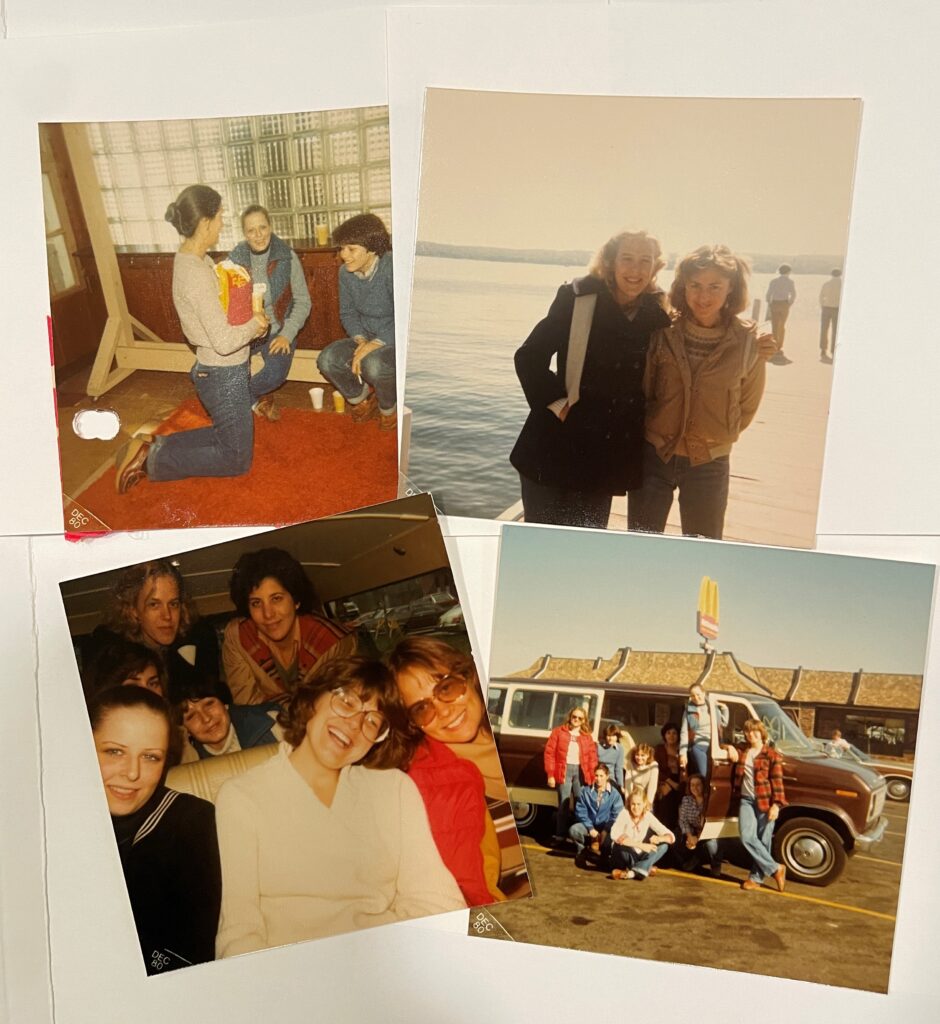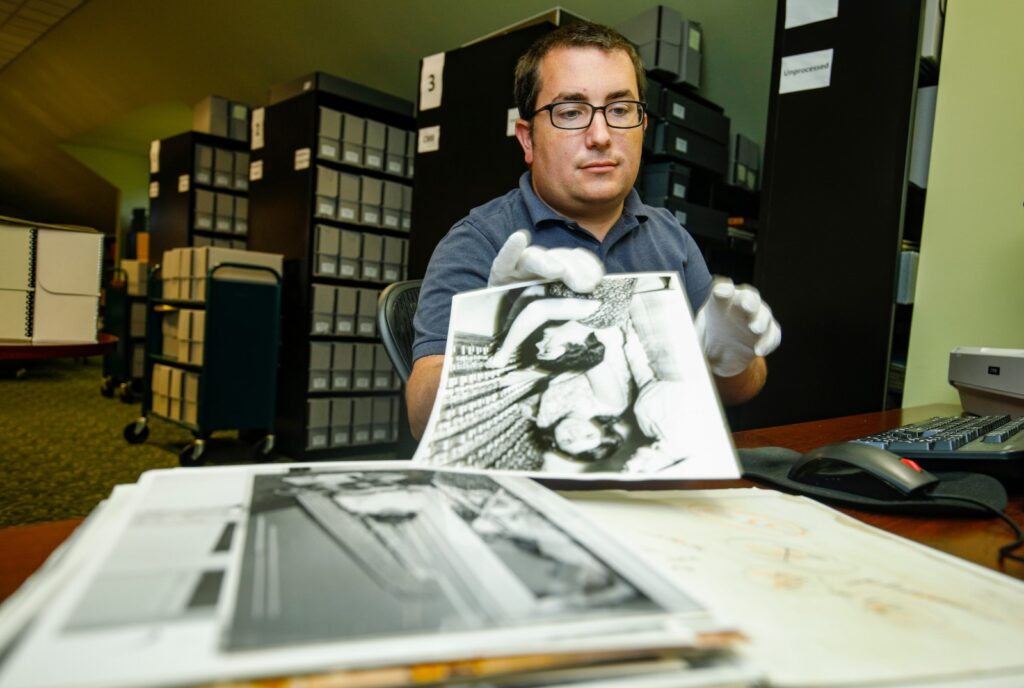Originally posted October 2015 on the WLA website. Updated February 2024.
It may be hard to remember a time before digital photography, when all photographs were printed out. Since the mid-2000s, most of the photos we have taken are in digital form. However, almost every photo taken before that time had a physical print or two with negatives often stored alongside them. Do you have boxes of personal and family photos sitting in a closet in your home?
Archivists often find photograph prints and negatives in the WLA collections and take steps to make sure these materials are preserved for generations of researchers to use. While you may not have climate-controlled storage areas and custom archival boxes, you can follow the same guidelines when handling and storing your photos to keep your memories safe.

Water, and Humidity, and Insects – Oh My!
The first task for storing photographs is to find a suitable environment. The key is to avoid areas with high temperatures and high relative humidity. Those conditions cater to the growth of mold and mildew and increase the rate of deterioration. The optimal temperature would be 68 degrees, but it is key to keep the temperature consistently below 75 degrees.
Keeping photographs out of the attic and basement is important if these areas are prone to fluctuations in temperature and condensation. When it is not possible to find an area that is consistent year-round, consider using dehumidifiers or fans to keep conditions stable. Be sure to keep photographs away from pipes and windows which could be sources of leaks. Storing photographs on a shelf will also help them stay dry in case of flooding. Place photographs away from areas storing food as that can be attractive to insects and rodents.
Don’t forget about your photo albums and scrapbooks! The same care needs to be taken to safeguard those memories for the future.

What’s in the Box?
The next step in storing personal photographs is finding a proper container or box to protect your snapshots from dust, light, and other damaging factors. Look for containers that are chemically stable and free of sulfur, acids, and peroxides. Any materials used should also be lignin-free (Lignin is a complex chemical compound that causes acid to re-form in paper over time and make the paper deteriorate and turn yellow.).
Just because it is in the scrapbook section of the store does not mean the product is safe for your photographs. Look for products that say “acid-free” and “lignin-free.” Photo storage supplies and albums can be found at craft stores and online.
Containers should be big enough for the originals to lay flat or upright without folding or bending. Do not overstuff a box but pack the materials so they do not shift around too much. You will probably want to organize your photos in small batches based on when they were taken or who is in the photos. Grouping in small batches also helps avoid dangerous shifting. Once again, look for folders that are free of sulfur, acids, peroxides, and lignin. Plastic sleeves should be made of uncoated polyester, polypropylene, or polyethylene. Store film negatives in a separate folder or sleeve from photographs as they can produce acidic gases as they age.
Photographs already stored in albums are safe to stay in the albums as long as the materials are archival safe. Avoid magnetic or self-adhesive albums as these types can damage photographs. Albums, like a container or box, protect the photograph from physical and environmental damage. Photographs also benefit from the support provided by individual pockets. When they are not displayed on your bookshelves, albums should be stored in the same kind of boxes or containers used to store photographs. Remember to find a box that the album fits in well so it will not move around.
Hands Up!
A crucial element of storing photographs is how you handle them. As hands can contain dirt and natural oils, there should be minimal handling of the photographs. Clean, lint-free gloves are recommended when touching photographs but if that is not possible handle photographs by the edges and touch them as little as possible. Follow these steps to handling photographs:
- View photographs in a clean, uncluttered area
- Wash and dry hands before getting started
- Wear clean cotton gloves if possible or touch only the edges
- Make sure to support the photograph to avoid damage
- Use only a soft lead pencil for making notes on the back of a photograph
- Do not use pens, stamps, or adhesive labels
- Do not use metal pins, paper clips, staples, or rubber bands to fasten or bind photographs
- Do not have food or drink near photographs

Who you gonna call? Conservators!
If your photographs are dirty, try carefully brushing them with a clean, soft brush by proceeding from the center outward to the edges. Never use erasers. Do not try to clean photographs with household cleaners. This could cause serious, irreparable damage.
Sometimes photographs may become attached to other materials. If there seems to be no way of detaching the items without causing damage it may be time to consult a photographic materials conservator. It is likely to be expensive, but a conservator may be the best option for saving a precious memory.
Digital Snapshot
Another way to preserve your printed photographs is to scan them and save them in a digital format. Scanning is an excellent way to be able to view photographs without handling them. Be sure to scan and save the photograph as a high-quality file. Do not use automatic feed scanners, especially with fragile, bent, or torn photographs. Scanning can be a time-consuming process, but it is well worth it if scanning ensures the longevity of your memories!

Remember to also care for your digital photographs. Extra care should be given to making sure your digital photos are properly stored and saved in multiple locations. For easy access, digital photos should be organized into well labeled folders. For safety, it would be wise to have at least two copies of the photo file, although three copies are recommended. One copy can be on a computer and the other should be saved externally whether it is on an external hard drive, or memory card or stick. Saving digital photographs in the cloud can be useful and convenient, but you should not rely on this as your only form of storage. In the future, be sure to update how you store your digital photographs. Technology changes and becomes obsolete very quickly, so you want to make sure you don’t lose access to them!
Hopefully these tips help you feel confident in the longevity of your captured memories. For more in-depth information, check out the preservation guides linked below.
Photograph Preservation guides:
- National Archives https://www.archives.gov/preservation/family-archives
- Library of Congress Digital Preservation: http://digitalpreservation.gov/personalarchiving
- American Institute for Conservation of Historic and Artistic Works: http://www.conservation-us.org/about-conservation/caring-for-your-treasures#.ViFadivYhsQ
- Find a photographic conservator: Conservation-us.org
Loyola University Chicago’s Women and Leadership Archives Blog is designed to provide a positive environment for the Loyola community to discuss important issues and ideas. Questions? Please contact the WLA at wlarchives@LUC.edu.
